Getting Back To Cartoony Cartoons Part 1
This is the first in a multi-part series on the subject of cartoons and cartoon making. My goal in these articles is to explore writing and making the short format cartoon which can range in length from 1 to 7 minutes.
I come from a very biased viewpoint that the short format cartoon is meant to be both entertaining and cartoony. You might think, “Well, OK that seems obvious.” But, it isn’t obvious at least not if you take a more critical look at many of the short format cartoons of recent times. The vast majority of today’s animated cartoons are marginally entertaining and they totally have lost sight of the cartoony aspects of the medium. Let’s begin with some historical perspective.
Walt Disney and others began with cartoons in the 1920’s and 1930’s that mostly capitalized on the audience of the time's total fascination with the newly developed medium of animation. It was all based on novelty. Things like basic moving pictures, sound and then color. If you go back and watch most of those cartoons today, they don't really hold up well as entertainment. Many were not much more than moving comic strips, others were mostly funny drawings dancing around to music. You can learn a lot from the series titles of these early works, Silly Symphonies, Merry Melodies, and Looney Tunes to name a few. They were all about the magic of and fascination with moving characters and music in syncronization in the new talking pictures. Merry Melodies and Looney Tunes evolved away from that format almost to the point that most people don't remember or realize the origin of those series names. Early cartoons were very innovative technically and we all owe a great deal of gratitude to those pioneers for their contributions and vision but they weren't cartoony.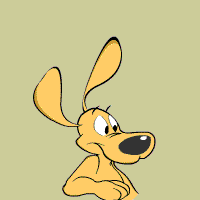
The late 1930's and 1940's saw real innovations and change in animated cartoons. Mostly lead by defectors from the Disney Studios, who craved more freedom of expression and rebelled against Walt's personal vision of animated film making. The most influential creators, in my opinion were Bob Clampett, Tex Avery, and Chuck Jones. I also think Friz Freleng and Robert McKimson are highly underrated but that's primarily due to the totally revolutionary and innovative levels of work produced by Clampett, Avery, and Jones. Clampett and Avery were much more aggressive and progressive. They were big risk takers and created very influential styles. To the extent that they pushed visual gags and exaggeration to their limits they can rightly be considered the visual masters and originators of the cartoony cartoon. Chuck Jones was much more conservative in his approach, but in the long run perhaps he is the best loved and remembered of the three. Clampett and Avery moved in leaps and bounds while Jones took lots of baby steps but ultimately produced the larger body of significant work. And as talked about in my prior article The Less Limited Expressive Possibilities of Limited Animation – Part 2, Jones created the model for the modern cartoon with his revolutionary work “The Dover Boys”.
Then came the UPA contribution to cartoon making, the hip, stylized, design oriented, limited animation works of the 1950’s. Although these cartoons were and still are considered highly influentual on today’s creators. It is also possible to point to them as the beginning of the decline in modern cartoon making. They were creative and inventive but yet they often in there attempt to achieve a level of New Yorker Magazine sophistication just plain weren’t that funny. They were more oriented to the stylized magazine humor of their time and they lost both the prior decades visual and situational cartoony edge
The next major group of really influential cartoons which I feel has great staying power and generational appeal came in the 1960's. They came from the combination of Jay Ward and Bill Scott. The Rocky and Bullwinkle series which included Fractured Fairy Tales and Dudley Do Right followed by George of the Jungle is still very funny stuff. Unlike the work of the Warner Bros and MGM studios of the prior group, Ward and Scott worked under a great handicap in terms of animation production (financially and politically they were forced to outsource their animation production to an inexperienced studio in Mexico) but they more than made up for it with great situations, inventive ideas and very funny dialogue and voice characterizations. In my opinion the Jay Ward Productions brought the cartoony back to cartoons although not the visual style of exaggeration made famous by Clampett, Avery and Jones.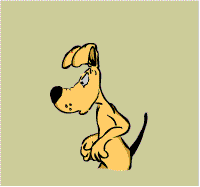
Then cartoons really entered the "dark ages" of their history for at least two decades. A period often referred to as the infomercial age of cartoons. From He-Man to Transformers to the Hanna Barbera line up on Saturday mornings it was one endless parade of mediocrity. Finally in the early 1990's a new life came back into cartoons. I think the most durable creation will be the Simpsons. I also like South Park but don't think it will be as long remembered. I think the most influential and greatest talents in recent animation are John Kricfalusi and Genndy Tartakovsky. Kricfalusi, much like his role model Bob Clampett, seems doomed to be his own worst enemy. He's brilliant, talented beyond imagination and totally able to "piss off" everyone in a position to help him get his work seen. But even though his own personal work will probably be more limited than it should be due to his personality and temperament, John Kricfalusi has in the last 10 plus years directly and indirectly influenced an entire generation of cartoon making talent. I predict that in twenty or thirty years, John Kricfaluci's work will be pointed to as timelessly great cartoons. Unfortunately his work won't be very well known because of its relatively small production volume. (Number of toons actually made). Genndy Tartakovsky continues to create new and highly innovative work and hopefully will return to his more humorous roots over time. Still with just a few exceptions today’s cartoons aren’t as clever in situation or humor or as visually exaggerated as their processors. They aren’t cartoony and in many cases they aren’t that entertaining. As cartoon makers we need to better understand what makes cartoons cartoony and set our sights to regain that former glory.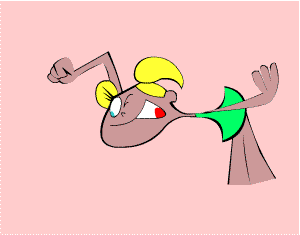
It doesn't matter how smooth the drawings or renderings. It doesn't matter what animation medium you choose, 2D, 3D CGI, claymation. It doesn't matter what your distribution medium, TV, Movie Theater, DVD, the Internet. Ultimately what you have to say trumps how you say it.The biggest limitation of short cartoons is time, so plot based stories should be avoided. And in general plot and character development are luxuries normally only afforded to continuing animated series. There the individual duration of the cartoon episodes is less limiting. But just because plot and character development can't occupy much time in a single cartoon episode, that doesn't mean that there is no need for good writing. To the contrary, good writing is critical. Writing is very much an art and not a science so there are no absolutes, everything is ultimately opinion at best.
So what are the elements that make for good cartoon writing? My experience points to the following elements: characterization, clever dialog, funny gags, interesting situations, and inventive ideas.
Characterization is really about creating well rounded and believable characters. These are characters which are multi-dimensional and who interact with and respond to other characters and situations in a manner consistent with their unique personalities. How the character acts and reacts and what they say and how they say it all contribute to developing a believable and well rounded character. The character has to do more than funny things and deliver more than just funny lines. They have to be funny naturally. By naturally we mean that everything they do must seem appropriate and natural for whom they are. If a character seems forced, or even worse, manipulated just for the sake of advancing the story or a gag then they will not be well written. Every character is a unique personality.
Natural actions and dialog are critical to good characterization, but dialog has to be more than just natural. (By natural I mean that the dialog naturally fits the unique personality of the character speaking) Dialog should follow distinct speech patterns and never sound forced, and it should be funny and "cartoony". Cartoony means the dialog is exaggerated, contrasty and almost poetic. Dialog should at its best be so funny and compelling and memorable that it makes people want to repeat it to others. It is totally natural for StrongBad to use a phrase like "crazy go nuts". It fits his personality and every HomeStarRunner viewer quickly picks up the phrase and passes it along. Cartoon dialog like comedy dialog has rhythm and timing, as does cartoon music and animation.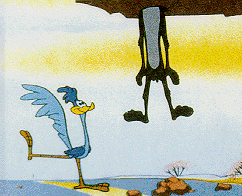
Before we begin exploring gags and how they are constructed, let's look at some of the classical situations that have successfully been used in developing many cartoons. Perhaps the most famous and most frequently used cartoon situation is the "chase". Usually a pair of characters is thrown together in this situation, the hunter and the hunted. Many classic "chases" come to mind with Wyle Coyote and Roadrunner as perhaps the purest example. The hunted character is always a sympathetic character and the hunter is usually the butt of most of the gags. What is very interesting is the observation that the hunter is usually also a sympathetic character. We care about them too, but we also love to watch them relentlessly try and fail in an ever escalating series of attempts to catch their desired pray. We love to see them fall to the bottom of that Grand Canyon in a puff of dust. We love seeing their inevitable recognition of gravity as they find themselves running in thin air. We love the bomb blowing up in their face and the boulder landing on them or the rocket strapped to their back pulling them headlong into a cliff wall. But we also really care about them and are secretly hoping they will succeed a little and we never really want them to be actually hurt because we just love the chase and the gags.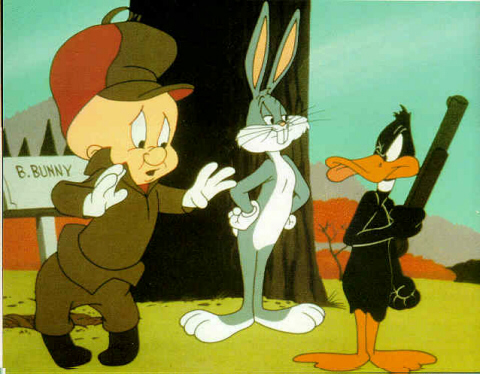
A variation of this "chase" situation is the "competition". My favorite example is Duck Season Wrabbit Season. In this type of situation we see two characters in a head to head competition where the gags sprout from their efforts. There are plenty more examples of this type of situation.
The next classic situation is the "lesson". One character for whatever reason is placed into the position of needing to instruct another character. The gags are usually focused on the teacher as everything they try to explain or demonstrate backfires. My favorite example of the lesson situation is the Foghorn Leghorn Little Chicken Hawk cartoons. Foghorn and the farm dog are bitter rivals while the Chicken Hawk is a clueless hunter. Foghorn takes the Hawk under his wing and nothing ever works as planned. Another great example of this cartoon situation was the series of Sylvester trying to teach his nephew to be a good mouser but he keeps running into the world’s largest and toughest mouse, actually a boxing kangaroo.
Another often used situation in cartoons is the "scheme" or the con job. One character sets out to pull off a scam with another character as the hapless dupe. Of course the con artist always seems to get the worst end of each transaction. Then there are the stereotypical "environment" situations. These are locations where one or more character is placed so the gags can flow. Example of these "environments" are the cemetery at midnight, a haunted house, a western saloon, a mad scientists laboratory, a rocket ship flying to mars. You have lots of preconditioned knowledge of these locations and stories centered on them so it is easy to construct gags making fun of the expected.
Yet another cartoon situation to consider is a variation on the "environment". It is the "parody". These situations take a familiar story and places one or more characters into that story in place of the original characters. There are tons of great "parody" examples; some are Robin Hood, Dragnet, Buck Rogers, and any one of a million fairy tales. Jay Ward made some of the funniest cartoons ever in his Fractured Fairy Tales segments on the Rocky and Bullwinkle shows. Just like the stereotypical "environment" these cartoons use your prior knowledge of the original story and characters as the source of their gags.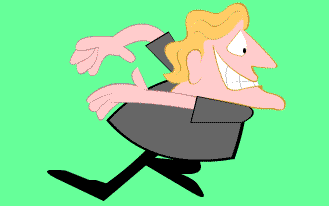
Inventive ideas are an important element in creating good cartoon writing. "Wow, that's like saying that overcoming gravity is important in flying an airplane". To a large degree how inventive we are in our creations is the essence of how well they are received. You can only drop large objects on to a character's head so many times before it stops being entertaining. Although the frog in the blender on the Internet was popular for quite some time, it certainly was never my cup of tea, no pun intended, but it was very inventive.
Certainly the choice of topics and characters is a major place to look for examples of inventive ideas. It was very inventive to take a sponge and turn it/him into a cartoon. It was very inventive to create a cartoon about a samurai warrior. And then even more inventive to take him totally out of his traditional environment and throw him into the future. Jay Ward was very inventive when he created the cartoon chapter play as a format first with Crusader Rabbit and later with Rocky and Bullwinkle. Ward also brought great inventiveness to cartoons with his "Fractured Fairy Tales", with "Aesop and Son", and with Sherman and Peabody's time travels in history. Another very inventive idea which Ward Productions really perfected was making the off camera announcer a straight man for setting up many gags. In fact the Ward folks actually made the announcer into an active character who became a part of the cartoon and even had conversations with the on screen cartoon characters.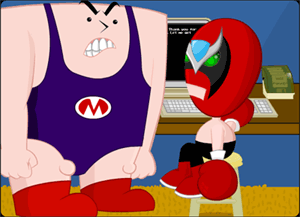
But I want to explore some examples at a less significant level in the creative process but that are certainly important in writing good cartoons. One of my favorite examples of a very inventive idea is Strong Bad's e-mails. What could be more natural than a web cartoon character sitting around answering viewers e-mails? And who could be better at doing that than a wise cracking guy like Strong Bad? There have been more than a hundred cartoons generated around this inventive idea and they are as fresh and funny now as ever.
Steve Whitehouse, one of my favorite web cartoon makers, very inventively uses sound effects and pantomime in his Mr. Man cartoons instead of dialog. If you have never watched Steve's Mr. Man Show where he produced 40 episodes about Mr. Man and Trio, the three wheeled dog, on vacation, then you have missed viewing a very well written, funny, and inventive example of the potential of web based animation. There are plenty of characters with a dog for a sidekick, but having the dog have no legs and instead having him squeak about on three wheels is just plain brilliant.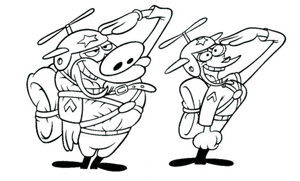
One of my favorite scenes in a cartoon is from a Ren and Stimpy episode Space Madness. The scene pans into a futuristic looking laboratory with Ren and Stimpy standing near a monolithic platform with a single red button in the center. Ren begins in characteristic frenzied dialogue to layout the setup for this gag. He tells Stimpy that it is his, Stimpy's, responsibility to guard the button and in no uncertain terms he must not press the button. The camera zooms in to reveal that this red button if pressed will "erase all history". Ren strongly reinforces the warning "Don't Press the Red Button"!!!! (We know what’s coming.) Ren leaves Stimpy alone on guard duty. The background music is straight out of a 1936 Flash Gordon serial. Stimpy is resolute in his duty. (But we know what's coming.) A narrator's "voice-over" begins in the background to build the anticipation and tension. The camera pulls back to reveal the narrator is actually standing there behind Stimpy, he's not just an off screen presence. We visually see Stimpy's internal turmoil as the urge to press the button wells up inside him. The torture to his very being is expressed in Kricfalusi's cartoony animation style. The narrator is steadily taunting Stimpy and literally climbs up on Stimpy's back and is bouncing his "butt" on to Stimpy forcing him closer and closer to pushing the red button. (We know what's coming, we have known all along, but by now we are rolling on the floor laughing.) Finally Stimpy can stand the pressure no more and presses the button. Ren rushes back into the scene as the three characters (Ren, Stimpy and the Narrator) all react in cartoony horror and anticipation of the pending disaster. The gag finishes when all three characters vanish in three black puffs of smoke. This is a really well structured gag. It begins with a strong set up, the warning. The audience is alerted and their expectations are established. Then the tension and anticipation is allowed to build. Great cartoony drawings and the inventive use of the narrator just layer on the absurdity of the situation. By the time we reach the gag's pay off, what was totally expected and predictable has evolved in a totally unexpected and unpredictable way. This sequence is perhaps one of the best combinations of the situational and visually cartoony elements of cartoon making. – End of Part 1 -
I come from a very biased viewpoint that the short format cartoon is meant to be both entertaining and cartoony. You might think, “Well, OK that seems obvious.” But, it isn’t obvious at least not if you take a more critical look at many of the short format cartoons of recent times. The vast majority of today’s animated cartoons are marginally entertaining and they totally have lost sight of the cartoony aspects of the medium. Let’s begin with some historical perspective.
Walt Disney and others began with cartoons in the 1920’s and 1930’s that mostly capitalized on the audience of the time's total fascination with the newly developed medium of animation. It was all based on novelty. Things like basic moving pictures, sound and then color. If you go back and watch most of those cartoons today, they don't really hold up well as entertainment. Many were not much more than moving comic strips, others were mostly funny drawings dancing around to music. You can learn a lot from the series titles of these early works, Silly Symphonies, Merry Melodies, and Looney Tunes to name a few. They were all about the magic of and fascination with moving characters and music in syncronization in the new talking pictures. Merry Melodies and Looney Tunes evolved away from that format almost to the point that most people don't remember or realize the origin of those series names. Early cartoons were very innovative technically and we all owe a great deal of gratitude to those pioneers for their contributions and vision but they weren't cartoony.

The late 1930's and 1940's saw real innovations and change in animated cartoons. Mostly lead by defectors from the Disney Studios, who craved more freedom of expression and rebelled against Walt's personal vision of animated film making. The most influential creators, in my opinion were Bob Clampett, Tex Avery, and Chuck Jones. I also think Friz Freleng and Robert McKimson are highly underrated but that's primarily due to the totally revolutionary and innovative levels of work produced by Clampett, Avery, and Jones. Clampett and Avery were much more aggressive and progressive. They were big risk takers and created very influential styles. To the extent that they pushed visual gags and exaggeration to their limits they can rightly be considered the visual masters and originators of the cartoony cartoon. Chuck Jones was much more conservative in his approach, but in the long run perhaps he is the best loved and remembered of the three. Clampett and Avery moved in leaps and bounds while Jones took lots of baby steps but ultimately produced the larger body of significant work. And as talked about in my prior article The Less Limited Expressive Possibilities of Limited Animation – Part 2, Jones created the model for the modern cartoon with his revolutionary work “The Dover Boys”.
Then came the UPA contribution to cartoon making, the hip, stylized, design oriented, limited animation works of the 1950’s. Although these cartoons were and still are considered highly influentual on today’s creators. It is also possible to point to them as the beginning of the decline in modern cartoon making. They were creative and inventive but yet they often in there attempt to achieve a level of New Yorker Magazine sophistication just plain weren’t that funny. They were more oriented to the stylized magazine humor of their time and they lost both the prior decades visual and situational cartoony edge
The next major group of really influential cartoons which I feel has great staying power and generational appeal came in the 1960's. They came from the combination of Jay Ward and Bill Scott. The Rocky and Bullwinkle series which included Fractured Fairy Tales and Dudley Do Right followed by George of the Jungle is still very funny stuff. Unlike the work of the Warner Bros and MGM studios of the prior group, Ward and Scott worked under a great handicap in terms of animation production (financially and politically they were forced to outsource their animation production to an inexperienced studio in Mexico) but they more than made up for it with great situations, inventive ideas and very funny dialogue and voice characterizations. In my opinion the Jay Ward Productions brought the cartoony back to cartoons although not the visual style of exaggeration made famous by Clampett, Avery and Jones.

Then cartoons really entered the "dark ages" of their history for at least two decades. A period often referred to as the infomercial age of cartoons. From He-Man to Transformers to the Hanna Barbera line up on Saturday mornings it was one endless parade of mediocrity. Finally in the early 1990's a new life came back into cartoons. I think the most durable creation will be the Simpsons. I also like South Park but don't think it will be as long remembered. I think the most influential and greatest talents in recent animation are John Kricfalusi and Genndy Tartakovsky. Kricfalusi, much like his role model Bob Clampett, seems doomed to be his own worst enemy. He's brilliant, talented beyond imagination and totally able to "piss off" everyone in a position to help him get his work seen. But even though his own personal work will probably be more limited than it should be due to his personality and temperament, John Kricfalusi has in the last 10 plus years directly and indirectly influenced an entire generation of cartoon making talent. I predict that in twenty or thirty years, John Kricfaluci's work will be pointed to as timelessly great cartoons. Unfortunately his work won't be very well known because of its relatively small production volume. (Number of toons actually made). Genndy Tartakovsky continues to create new and highly innovative work and hopefully will return to his more humorous roots over time. Still with just a few exceptions today’s cartoons aren’t as clever in situation or humor or as visually exaggerated as their processors. They aren’t cartoony and in many cases they aren’t that entertaining. As cartoon makers we need to better understand what makes cartoons cartoony and set our sights to regain that former glory.

It doesn't matter how smooth the drawings or renderings. It doesn't matter what animation medium you choose, 2D, 3D CGI, claymation. It doesn't matter what your distribution medium, TV, Movie Theater, DVD, the Internet. Ultimately what you have to say trumps how you say it.The biggest limitation of short cartoons is time, so plot based stories should be avoided. And in general plot and character development are luxuries normally only afforded to continuing animated series. There the individual duration of the cartoon episodes is less limiting. But just because plot and character development can't occupy much time in a single cartoon episode, that doesn't mean that there is no need for good writing. To the contrary, good writing is critical. Writing is very much an art and not a science so there are no absolutes, everything is ultimately opinion at best.
So what are the elements that make for good cartoon writing? My experience points to the following elements: characterization, clever dialog, funny gags, interesting situations, and inventive ideas.
Characterization is really about creating well rounded and believable characters. These are characters which are multi-dimensional and who interact with and respond to other characters and situations in a manner consistent with their unique personalities. How the character acts and reacts and what they say and how they say it all contribute to developing a believable and well rounded character. The character has to do more than funny things and deliver more than just funny lines. They have to be funny naturally. By naturally we mean that everything they do must seem appropriate and natural for whom they are. If a character seems forced, or even worse, manipulated just for the sake of advancing the story or a gag then they will not be well written. Every character is a unique personality.
Natural actions and dialog are critical to good characterization, but dialog has to be more than just natural. (By natural I mean that the dialog naturally fits the unique personality of the character speaking) Dialog should follow distinct speech patterns and never sound forced, and it should be funny and "cartoony". Cartoony means the dialog is exaggerated, contrasty and almost poetic. Dialog should at its best be so funny and compelling and memorable that it makes people want to repeat it to others. It is totally natural for StrongBad to use a phrase like "crazy go nuts". It fits his personality and every HomeStarRunner viewer quickly picks up the phrase and passes it along. Cartoon dialog like comedy dialog has rhythm and timing, as does cartoon music and animation.

Before we begin exploring gags and how they are constructed, let's look at some of the classical situations that have successfully been used in developing many cartoons. Perhaps the most famous and most frequently used cartoon situation is the "chase". Usually a pair of characters is thrown together in this situation, the hunter and the hunted. Many classic "chases" come to mind with Wyle Coyote and Roadrunner as perhaps the purest example. The hunted character is always a sympathetic character and the hunter is usually the butt of most of the gags. What is very interesting is the observation that the hunter is usually also a sympathetic character. We care about them too, but we also love to watch them relentlessly try and fail in an ever escalating series of attempts to catch their desired pray. We love to see them fall to the bottom of that Grand Canyon in a puff of dust. We love seeing their inevitable recognition of gravity as they find themselves running in thin air. We love the bomb blowing up in their face and the boulder landing on them or the rocket strapped to their back pulling them headlong into a cliff wall. But we also really care about them and are secretly hoping they will succeed a little and we never really want them to be actually hurt because we just love the chase and the gags.

A variation of this "chase" situation is the "competition". My favorite example is Duck Season Wrabbit Season. In this type of situation we see two characters in a head to head competition where the gags sprout from their efforts. There are plenty more examples of this type of situation.
The next classic situation is the "lesson". One character for whatever reason is placed into the position of needing to instruct another character. The gags are usually focused on the teacher as everything they try to explain or demonstrate backfires. My favorite example of the lesson situation is the Foghorn Leghorn Little Chicken Hawk cartoons. Foghorn and the farm dog are bitter rivals while the Chicken Hawk is a clueless hunter. Foghorn takes the Hawk under his wing and nothing ever works as planned. Another great example of this cartoon situation was the series of Sylvester trying to teach his nephew to be a good mouser but he keeps running into the world’s largest and toughest mouse, actually a boxing kangaroo.
Another often used situation in cartoons is the "scheme" or the con job. One character sets out to pull off a scam with another character as the hapless dupe. Of course the con artist always seems to get the worst end of each transaction. Then there are the stereotypical "environment" situations. These are locations where one or more character is placed so the gags can flow. Example of these "environments" are the cemetery at midnight, a haunted house, a western saloon, a mad scientists laboratory, a rocket ship flying to mars. You have lots of preconditioned knowledge of these locations and stories centered on them so it is easy to construct gags making fun of the expected.
Yet another cartoon situation to consider is a variation on the "environment". It is the "parody". These situations take a familiar story and places one or more characters into that story in place of the original characters. There are tons of great "parody" examples; some are Robin Hood, Dragnet, Buck Rogers, and any one of a million fairy tales. Jay Ward made some of the funniest cartoons ever in his Fractured Fairy Tales segments on the Rocky and Bullwinkle shows. Just like the stereotypical "environment" these cartoons use your prior knowledge of the original story and characters as the source of their gags.

Inventive ideas are an important element in creating good cartoon writing. "Wow, that's like saying that overcoming gravity is important in flying an airplane". To a large degree how inventive we are in our creations is the essence of how well they are received. You can only drop large objects on to a character's head so many times before it stops being entertaining. Although the frog in the blender on the Internet was popular for quite some time, it certainly was never my cup of tea, no pun intended, but it was very inventive.
Certainly the choice of topics and characters is a major place to look for examples of inventive ideas. It was very inventive to take a sponge and turn it/him into a cartoon. It was very inventive to create a cartoon about a samurai warrior. And then even more inventive to take him totally out of his traditional environment and throw him into the future. Jay Ward was very inventive when he created the cartoon chapter play as a format first with Crusader Rabbit and later with Rocky and Bullwinkle. Ward also brought great inventiveness to cartoons with his "Fractured Fairy Tales", with "Aesop and Son", and with Sherman and Peabody's time travels in history. Another very inventive idea which Ward Productions really perfected was making the off camera announcer a straight man for setting up many gags. In fact the Ward folks actually made the announcer into an active character who became a part of the cartoon and even had conversations with the on screen cartoon characters.

But I want to explore some examples at a less significant level in the creative process but that are certainly important in writing good cartoons. One of my favorite examples of a very inventive idea is Strong Bad's e-mails. What could be more natural than a web cartoon character sitting around answering viewers e-mails? And who could be better at doing that than a wise cracking guy like Strong Bad? There have been more than a hundred cartoons generated around this inventive idea and they are as fresh and funny now as ever.
Steve Whitehouse, one of my favorite web cartoon makers, very inventively uses sound effects and pantomime in his Mr. Man cartoons instead of dialog. If you have never watched Steve's Mr. Man Show where he produced 40 episodes about Mr. Man and Trio, the three wheeled dog, on vacation, then you have missed viewing a very well written, funny, and inventive example of the potential of web based animation. There are plenty of characters with a dog for a sidekick, but having the dog have no legs and instead having him squeak about on three wheels is just plain brilliant.

One of my favorite scenes in a cartoon is from a Ren and Stimpy episode Space Madness. The scene pans into a futuristic looking laboratory with Ren and Stimpy standing near a monolithic platform with a single red button in the center. Ren begins in characteristic frenzied dialogue to layout the setup for this gag. He tells Stimpy that it is his, Stimpy's, responsibility to guard the button and in no uncertain terms he must not press the button. The camera zooms in to reveal that this red button if pressed will "erase all history". Ren strongly reinforces the warning "Don't Press the Red Button"!!!! (We know what’s coming.) Ren leaves Stimpy alone on guard duty. The background music is straight out of a 1936 Flash Gordon serial. Stimpy is resolute in his duty. (But we know what's coming.) A narrator's "voice-over" begins in the background to build the anticipation and tension. The camera pulls back to reveal the narrator is actually standing there behind Stimpy, he's not just an off screen presence. We visually see Stimpy's internal turmoil as the urge to press the button wells up inside him. The torture to his very being is expressed in Kricfalusi's cartoony animation style. The narrator is steadily taunting Stimpy and literally climbs up on Stimpy's back and is bouncing his "butt" on to Stimpy forcing him closer and closer to pushing the red button. (We know what's coming, we have known all along, but by now we are rolling on the floor laughing.) Finally Stimpy can stand the pressure no more and presses the button. Ren rushes back into the scene as the three characters (Ren, Stimpy and the Narrator) all react in cartoony horror and anticipation of the pending disaster. The gag finishes when all three characters vanish in three black puffs of smoke. This is a really well structured gag. It begins with a strong set up, the warning. The audience is alerted and their expectations are established. Then the tension and anticipation is allowed to build. Great cartoony drawings and the inventive use of the narrator just layer on the absurdity of the situation. By the time we reach the gag's pay off, what was totally expected and predictable has evolved in a totally unexpected and unpredictable way. This sequence is perhaps one of the best combinations of the situational and visually cartoony elements of cartoon making. – End of Part 1 -

0 Comments:
Post a Comment
<< Home